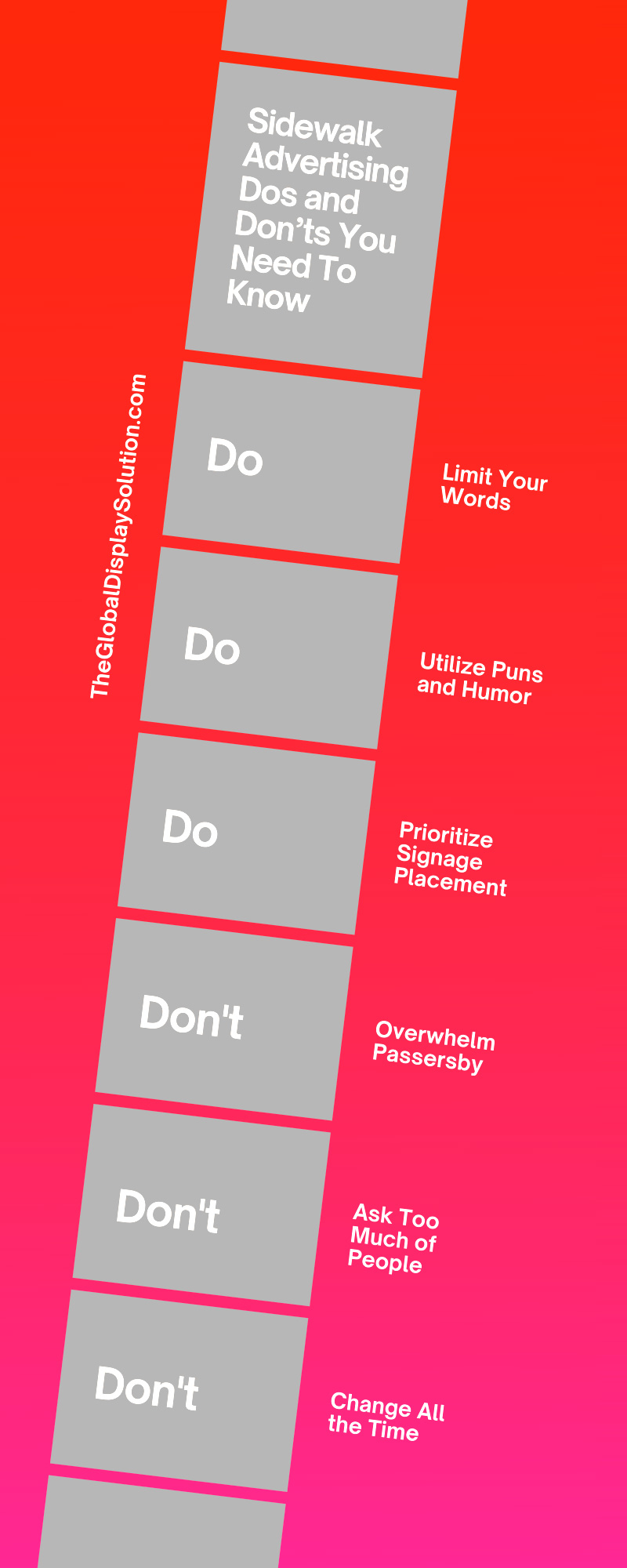Sidewalk Advertising Dos and Don’ts You Need To Know
June 14, 2021, 2:03 am
Marketing is all about placement and creativity. You take time to workshop an idea and use it to bring consumers into your store. But an effective marketing plan will include more than a good concept—you need thoughtful ad placement, too. Here are the sidewalk advertising dos and don’ts you need to know.
Sidewalk Advertising Dos
Outdoor advertising requires careful planning and marketing adjustments. If you want to maximize your effectiveness, you should try these sidewalk advertising best practices.
Limits Your Words
People see sidewalk ads when they glance around the street in front of them; they’re not eagerly searching to see and read your sign. Instead of putting your entire mission statement and every item on your menu on a simple sidewalk sign, limit your words. The fewer words you use, the quicker your message gets across. If someone sees a sign with too many words, they’ll quickly become disinterested and move on without a second look.
When crafting your words, you should think about the best way to explain your store or concept. If you want to advertise a sale, you can simply write, “Sale! 25% Off Winter Clothes!” You shouldn’t write the entire backstory on the sign by saying, “We are emptying our shelves of all winter clothes for the new seasons! Please come help us and take advantage of our 25% off sale this week!” It may look ridiculous to write all this out, and you should save such detailed explanations for social media posts or mass emails.
Utilize Puns and Humor
Everyone loves to laugh, and a good joke is the best vehicle for laughter. Marketers spend hours formulating the perfect jokes for their target audiences that mix genuine creativity with on-brand ideas. It’s often difficult to mix humor with business concepts, but you can make people belly laugh when you find the right connection.
While your marketers may not be stand-up comedians, you can always settle for a quirky pun. People don’t need to laugh out loud to appreciate the subtlety of wordplay or a quick pun. Even if you get a tiny smirk out of someone, that’s all you need. At the end of the day, you want to engage people with a funny idea or pun that will stick with them and create more associations with your business. That way, when people repeat your pun to others, they’ll also pass along the name of your store where they saw it.
Prioritize Signage Placement
You could develop the funniest, cutest, most attractive ad, but no one will see it unless you place it within view. Visibility is a huge part of sidewalk advertising success. Depending on the amount of foot traffic on your street, you could have hundreds of people bustling past your storefront every day. That’s why you need a sturdy and bold sidewalk sign holder, like an a-frame sign. People love seeing what a business owner writes on a chalk sign and the new daily deals.
Though a-frame signs live on the ground, they’re right in people’s paths, so you know they must look at and navigate around the sign to continue walking. Pedestrian commuters will grow accustomed to your sign, and it’ll stay in their view the whole time.
Sidewalk Advertising Don’ts
Now that you know the best things to do for your outdoor signage, you should caution yourself against the following bad ideas. Even just one of these mistakes could offset the marketing impact you worked so hard to implement.
Don’t Overwhelm Passersby
People who pass by your outdoor advertisements are almost always on the move. They will seldom stop to read every line on your sidewalk poster or sign. That’s why you should prioritize your brand identity and develop a familiarity with the customer. Those who walk by your shop every day will recognize you as the people with the sign outside. Over time, they will read the daily specials or seasonal deals and consider stopping in—until one day, they visit your store.
Don’t Ask Too Much of People
Some sidewalk signage asks people to act quickly and dial a number or send a text to the store. While this may work with a few people, the majority of passersby will ignore the information or feel stressed at the idea of reaching out to a business cold turkey. You should avoid listing your email or phone information and list your social media handles instead.
A phone call or email suggests that the customer formulate their own ideas and reach out to you with a specific question. Social media profiles are quick to look up, and they only require people to view posts, not engage with them. In doing so, you take the ball out of the customer’s court and just ask them to make a connection. That way, when people look you up online, they are doing so of their own volition, and that is all the work you expect on their end.
Don’t Change All the Time
One of the hardest challenges facing businesses is the pressure to fuel creativity and always innovate new and exciting ideas. While innovation surely has its place in business, it’s better to remain consistent than change all the time.
Suppose you have a sidewalk sign for your supermarket. You start out with an a-frame chalk sign with handwritten deals on the board. The next week, you tell customers about your new products. Then, you advertise your hot meal section, only to return to promotional deals the next week. Along the way, you also switch from handwritten chalk signs to printed posters.
While each of these ideas in and of themselves are effective marketing strategies to get the word out about your products, the lack of consistency may throw your audience. You ultimately want people who pass by each day to count on the same information shared in the same way. When you tell a coherent story, people are more likely to understand your business and come inside.
With these sidewalk advertising dos and don’ts you need to know in your back pocket, you can make the best marketing decisions for your business. If you have any questions about advertisement display, contact us at The Global Display Solution today.


